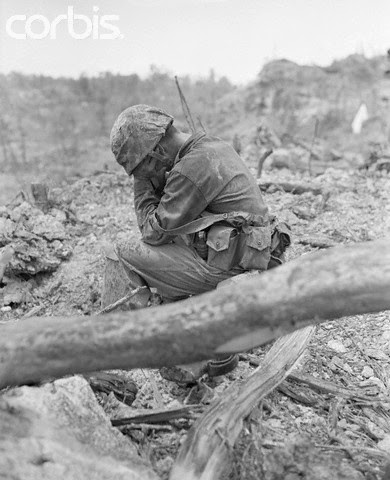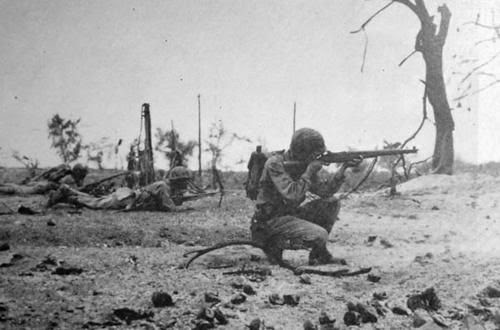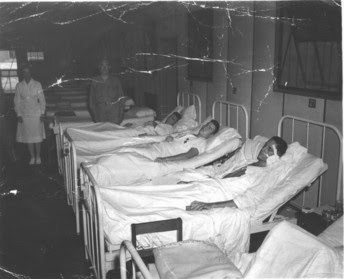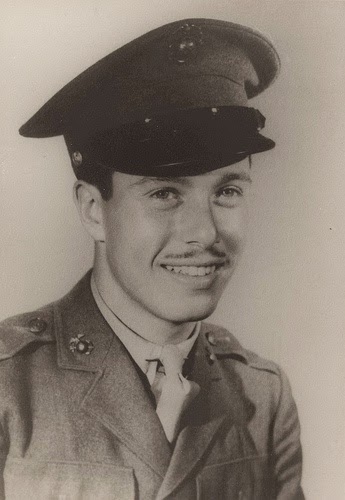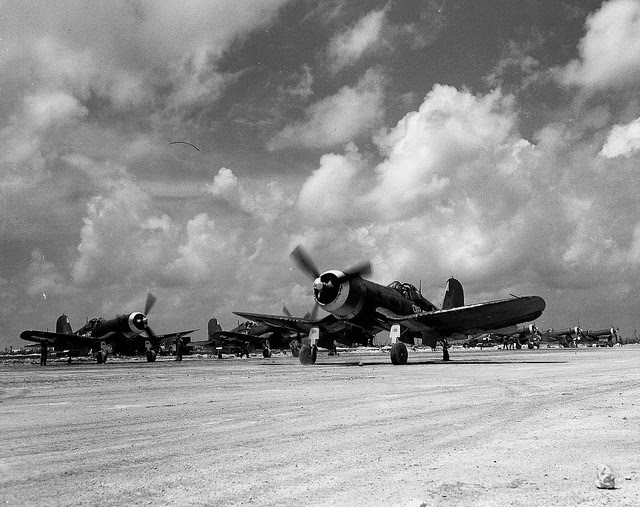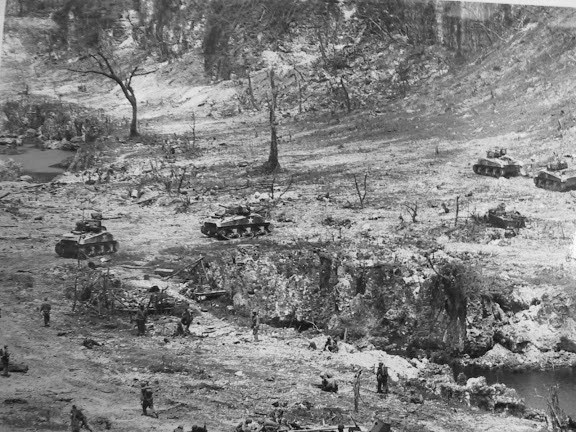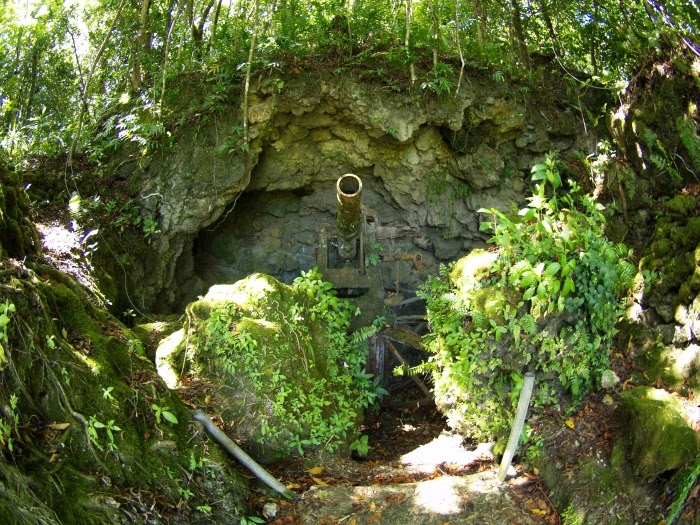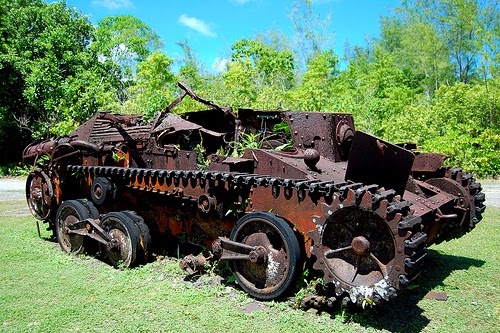 |
| The SS Major and the station |
A Nondescript Radio Station in the Middle of Nowhere
The radio station at Gleiwitz, Germany was nothing special. Its tower was erected on August 1, 1934 as Sendeturm Gleiwitz (Gleiwitz Radio Tower. The Reichssender Breslau (former Schlesische Funkstunde broadcasting corporation) of the Reichs-Rundfunk-Gesellschaft radio network operated it. The tower was typical for its time, modelled on the Mühlacker radio transmitter, and was considered a big improvement for the broadcasting company. It replaced a smaller transmitter located a few streets over on Raudener Straße and went in service on 23 December 1935.
Normally, nobody would care about this tower, which but for one incident on one night while the world was a peace would have served a normal life and then no doubt have been taken down and scrapped, to be turned into razor blades. However, this radio tower is special, because it led to something on the order of 50 million or so deaths. And the only reason that happened is because it just so happened to be near the border with Poland.
A Hungry Man
Adolf Hitler was hungry, but not for his usual mostly vegetarian menu. He had gobbled up Austria with the Anschluss of 1938 and the Sudetenland in Czechoslovakia the same year (followed up by what little remained of the country in 1939). What Hitler was hungry for was territory, or what he called Lebensraum ("living space"), and he was in a hurry.
He had given the Poles part of Czechoslovakia to help justify his own aggrandizement there, and he did not have a very high opinion of the Polish military. Hitler had long held the Untermensch ("inferior people") of Poland in contempt, and it seemed preposterous to him that the Poles should have adopted airs after World War I of being a military power. There were many ethnic Germans living under Polish rule after the redrawing of boundaries in Paris. In particular, the Germans coveted a slice of land known as the "Polish Corridor," a narrow parcel which physically divided Germany into two parts, separating the "homeland" of the Prussian military aristocracy from Berlin. The League of Nations had given the land to Poland following World War 1 in order to grant them access to the sea. Hitler intended to invade this area as well as the rest of Poland, but he knew that attacking without clear justification would upset the citizens of his country and amplify the repercussions from other nations.
 |
| Hitler gobbling up Czechoslovakia at Munich in 1938 |
There was only one problem: the Poles hadn't done anything, and there hadn't been the groundwork laid carefully as by the Sudetenland ethnic Germans to justify "protecting" the ethnic German Poles. Sure, he had given ferocious speeches making claims that Germans living in Poland were the subjects of terrible persecution, just like he had about Czechoslovakia, but he needed a pretext. If nothing else, Adolf Hitler was all about legal pretexts. The Munich Pact with Neville Chamblerlain and the others had given him
carte blanche in the earlier case, but the British and the French could not be counted upon to do the same regarding the Poles, because they actually took their defense guarantees to that country seriously.
What to do, what to do.
Operation Himmler
Hitler did what he usually did in similar situations: he turned to his Party comrade "old reliable Henry" ("Der Truer Heinrich"). Commander
Heinrich Himmler of the SS conceptualized and set in motion a collection of deceptions designed to make war appear inevitable, an undertaking which he rather self-consciously code-named Operation Himmler. Operation Himmler was a series of contemplated operations to be undertaken as propaganda measures to pave the way for Germany’s invasion of Poland. The incident at Gleiwitz would be a particular operation within the larger Operation Himmler.
 |
| Himmler and Hitler went way back |
Himmler turned to his cronies in the Gestapo and other branches of the German secret police, and together they worked up a plan. This operation would have to be quick and dirty, no more of the years-long hatching of a plot. That sort of thing was so 1938, and with Stalin in on things and eager for his cut, there was no time to wait. Various "incidents" would have to be manufactured. That is where an SS Major named Al comes in.
Operation Grandmother Died
SS-Sturmbannfuhrer (Major) Alfred Naujocks explained to writer Comer Clarke in 1958 that in the summer of 1939, apparently August 10, 1939, he was summoned to the Berlin office of Reinhard Heydrich, head of the German secret police.
 |
Alfred Naujocks and the Gleiwitz radio station
|
Naujocks’ meeting with Heydrich was startling in its anticipation of far-reaching events:
‘Heydrich told me ‘Within a month we shall be at war with Poland. The Führer is determined. But first we have to have something to go to war about. We’ve organized incidents in Danzig, along the East Prussian border with Poland, and along the German frontier. But there has to be something big and obvious.’’
Naujocks described how Heydrich strode over to a wall map of Eastern Europe and stabbed a finger at Gleiwitz:
‘This is where you come in. The idea is that six men and yourself will burst into Gleiwitz radio station, knock out the staff and broadcast a speech in Polish and German, attacking Germany and the Führer and announcing Poland’s intention of taking the disputed territories by force.’
Heydrich further told how a body, dressed in Polish uniform, was to be left on the radio station steps to ‘prove’ the Polish connection. The top secret operation at Gleiwitz was given a new code word: Grossmutter gestorben, (‘Grandmother died’). This was the least war-like codename of the entire Third Reich period, which usually had bombastic names such as Operation Barbarossa (invasion of the USSR) and Operation Götz von Berlichingen (air attack on the Russian Navy at Leningrad). However, it was most descriptive and a lot more accurate than the others.
The plan, thus, was set: they would invade Poland under a pretext, a "false flag" event. The next project was to damp down any outside interference. Soviet Premier Josef Stalin had seen how worthless the Western security guarantees had been regarding the Czechs, and he was a little hungry himself. He had his foreign Minister, Molotov, tell German Foreign Minister Ribbentrop that they could do a deal. This was done speadily in Moscow in the Stalin/Ribbentrop pact of August 23, 1939. Stalin agreed to do to Poland what Hitler and (ironically) the Poles, along with the other surrounding nations, had done to Czechoslovakia - carve it up between them.
The Wehrmacht already was concentrating their soldiers and war-making machines along the Polish border in preparation for an all-out attack. Given the pact with Stalin, Hitler was ready. He still wanted, though, that pretext, for whatever good it would do. He had a very legalistic mind at times, Adolf Hitler.
On 31 August, Naujocks went to Gleiwitz and waited by the 380-foot broadcasting tower with six other storm troopers. They were all dressed in Polish military uniforms, though they were most definitely German soldiers in Germany. The men just needed a delivery, one of ‘Konserve’ or ‘canned meat (goods)’ -- a German euphemism for expendable concentration camp convicts. SS agents showed up and dumped off the body of an unconscious man, one Franciszek Honiok. This was the canned meat.
 |
Franciszek Honiok, the Silesian killed by the Germans on Aug. 31, 1939 for the Gleiwitz false flag operation, and the first victim of World War II.
|
Honiok was a nobody, a simple 43-year-old Catholic farmer. He was a Silesian known for sympathizing with his people, the Poles. The SS had arrested him the day before, on August 30, 1939, in the Silesian village of Polomia basically for being annoying. He appears to have been selected because of his involvement in a number of local revolts against German rule in Silesia, a border region spanning present day Poland, Germany and the Czech Republic.According to his surviving family in Poland, Honiok identified strongly with Silesia and Poland, so he was a bit of a rabble-rouser - and Germans hated people like that. There were many such protesters, it could have been anybody, unluckily for Honiok it was him.
 |
The Gleiwitz Case (Der Fall Gleiwitz) is director Gerhard Klein’s 1961 version
|
The Germans no doubt had a good laugh later about having used this pain-in-the-butt fellow who was so vocal about his people's "rights" to steal their land for good (they thought). Similar tales are told about the German bigwigs making snarky comments about some proposed victims during the June 1934 Night of the Long Knives. However, Honiok had the last laugh, in a way: at least his death entered the history books, unlike so many millions of other victims of the war and Holocaust who disappeared without a trace. Honiok’s death has never been marked with any sort of remembrance in Poland and his burial site is unknown.
The SS men hastily changed Honiok into Polish clothing and carried him over to the station building at about 8:00 pm. A doctor had administered a lethal injection before Franz at the concentration camp before he was transported to the site, but it had yet to take full effect when the SS men riddled him with pistol rounds on the ground outside the radio station. They then left him as conspicuously as possible, splayed across the entrance steps. Subtlety had never been a German attribute. It was all done very coldly and in such a way that even an independent autopsy would verify that the man had been shot while alive and wearing a Polish uniform on German soil - which was all very much true. However, how Honiok got that way most definitely was not as it may have seemed.
Naujocks and his operatives then entered the Gleiwitz radio station and promptly seized control of the equipment, shut down the regular signal, and powered up the emergency transmitter. The microphone was given to a Polish-speaking operative, who read a prepared speech about three minutes long, urging Poles to rise up and help in the invasion of Germany. At the end of the transmission, the officers fired their pistols repeatedly for the benefit of anyone who might be listening, and departed.
During the night a handful of other such incidents were executed elsewhere along the border, using other "canned goods" from German prisons to create the illusion that Polish soldiers were attacking German troops. Almost immediately after the “Gleiwitz incident,” every German radio station, in a carefully coordinated move, broadcast the words used by the “invaders,” and claimed that bodies of Polish regular soldiers who were killed in the incident remained at the scene. There have been rumors that some of the German radio stations broadcast the "news"
before it actually happened, but that does not seem to have been the case.
Hitler is Shocked, Shocked at this Miscarriage of Justice
The following day the bodies of the dead prisoners were presented to the press and to police as evidence of the Poles' organized aggression against the Germans. Hitler pompously addressed the German Army with carefully amplified outrage:
"The Polish State has refused the peaceful settlement of relations which I desired, and has appealed to arms. Germans in Poland are persecuted with bloody terror and driven from their houses. A series of violations of the frontier, intolerable to a great Power, prove that Poland is no longer willing to respect the frontier of the Reich."In order to put an end to this lunacy, I have no other choice than to meet force with force from now on. The German Army will fight the battle for the honour and the vital rights of reborn Germany with hard determination. I expect that every soldier, mindful of the great traditions of eternal German soldiery, will ever remain conscious that he is a representative of the National-Socialist Greater Germany. Long live our people and our Reich!"
The German military attacked on that very morning, with the old battleship Schleswig-Holstein firing shots well before Hitler's speech. Adolf Hitler used the Gleiwitz ruse as his excuse to declare war on Poland later that day, September 1, 1939, initiating World War II. Addressing the Reichstag, he stated that he was outraged that the violation of German territory by “Polish Army hooligans had finally exhausted our patience.”
 |
| Hitler addressing his loyal lackeys |
British, French and other European governments were notified that Poland had started the war. It took them a while to figure out what was going on, and England did not honor its guarantee to Poland until two days later. Hitler’s plan, while it fooled nobody, at least ensured that the German army would gain vital hours as ministers argued over whether any nation could be so evil as to concoct such a scheme. They ultimately concluded, apparently so
 |
| Time Magazine, September 25, 1939 |
After waiting a decent interval of a couple of weeks, long enough for the Germans to draw in the Polish reserves, Stalin attacked Poland from the east to get his share. Within a week of the attack, Germany claimed victory over the Polish Corridor, and the Polish capital of Warsaw was captured in just over a month. That was it for 1939 aside from a few bombing raids and naval actions, such as the cornering of the pocket battleship Graf Spee in the River Platte.
The Fortunes of War Change
Events moved along, and German fortunes rose and fell. Five years later, in November 1944, as things were starting to look really dicey for the Germans, Alfred Naujocks deserted his post and surrendered himself to Allied forces. He was held as a suspected war criminal, and he spent the remaining few months of the war in detention. Six years after playing his part in the deceit at Gleiwitz he testified at the Nuremberg trials, where he retold the events of that world-changing evening in 1939:
"On or about 10 August 1939 the Chief of the Sipo and SD, Heydrich, personally ordered me to simulate an attack on the radio station near Gleiwitz, near the Polish border, and to make it appear that the attacking force consisted of Poles.
Heydrich said: 'Actual proof of these attacks of the Poles is needed for the foreign press, as well as for German propaganda purposes.'""Heydrich said, 'In order to carry out this attack, report to Muller for "Canned Goods."' I did this and gave Muller instructions to deliver the man near the radio station.
I received this man and had him laid down at the entrance to the station. He was alive, but he was completely unconscious. I tried to open his eyes. I could not recognize by his eyes that he was alive, only by his breathing."
"We seized the radio station as ordered, broadcast a speech of 3 to 4 minutes over an emergency transmitter, fired some pistol shots, and left."
 |
| Alfred Naujocks testifying at Nuremburg |
After the Nuremberg trials were closed, Alfred Naujocks sold his story to the media and became a businessman in Hamburg. He was later suspected of participating in ODESSA-- an organized effort to smuggle SS officers out of the country to avoid prosecution-- but his guilt was never determined. He died in the 1960s, though there is uncertainty regarding the exact year of his death (a common issue with Germans fleeing Germany after the war). Because it was by his hand that the deception at Gleiwitz was ultimately carried out, Alfred Naujocks has received a particularly grim moniker amongst many historians: he was The Man Who Started the War. This is somewhat unfair, but he did kill Honiok in cold blood, and that is enough to remove any vestige of sympathy we may feel for him.
Ironies
The powers that be came and went, Hitler wound up dead in a bunker by his own hand and Stalin died in his sleep, perhaps poisoned. The Gleiwitz radio station, though, went on. Renamed Gliwice after the war, the town used it, from 4 October 1945, until the inauguration of the new transmitter in Ruda Śląska in 1955, for medium wave broadcasting of the Polish Public Broadcasting Company. After 1955, it was used as a jammer against medium wave transmitters broadcasting Western Polish-language programmes, e.g. Radio Free Europe. This radio transmitter had quite a history, always being used against the Western powers in one way or another.
Following a decision of the Gliwice City Council taken on 2 December 2004, the radio tower was shut down for good and became a museum on radio history and visual arts, located in the former radio transmitter building.
 |
Gleiwitz Radio Station, now a museum
|
Thus the station, the cause of more death and destruction than any other site in human history not only was untouched by the savagery of the war that ebbed and flowed across it, was not only untouched by any damage, but it has been preserved for posterity when all similar stations have long since been scrapped.
Honiok, meanwhile, the footnote within a footnote within a footnote, has not been completely forgotten. While his relatives understandably have learned from Honiok's experience and others that silence is usually golden in that part of the world, Pawel Honiok, his nephew and only remaining relative, has said:
“Nobody has ever wanted to talk about what happened, it’s always been secret. The Germans were in control of us until 1945 and then the Russians took over and they had no interest in digging up the truth about what had happened back at the start of the war. Even my own family were too afraid to talk about it when I was a child, and it was many, many years before we started to hear anything at all about what happened to him.”
“They never even accepted he was a victim of the war because he was killed on the evening of August 31 and, officially, the war did not begin until September 1,” Pawel Honiok said. “But now, people accept he was the first person killed in that war.”
And there you have it - the man who inadvertently and certainly unwillingly started World War wasn't even considered part of it until recently.
 |
Gliwice radio tower today
2014
|























